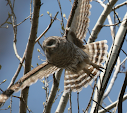
For my lunch break today I decided to head over to a little trailhead on the way to Marshall Mesa where I had some luck finding bluebirds earlier in the spring. This time I was more interested in the two marshy ponds that are full of cattails and were places I considered good possible locations for shorebirds or waterfowl.
I was immediately successful locating Yellow-Headed Blackbirds which were present in the best numbers I have seen yet. They were vocalizing with a click that sounds exactly like a modern driver making good contact with a golf ball. I wonder if they have always done that, or if it gets mimicked from being heard on all the golf courses with marshy wetlands?

There wasn't much variety in the ponds, but as I was watching I saw and photographed one individual in each of the three following Sparrow species. The Vesper Sparrow is above. I noticed the breast spot, but that the bird's colors seemed more faded than a Song Sparrow and started my searching from there. The white eyering really helped to dial this ID in.

This next Sparrow is a Brewer's, the field marks are visible even though the colors were a bit washed out by the direct sun. Here I noted the pale, light-gray underside with no streaking. The white eyering, coupled with the thin moustache and eyelines were good clues as well. Finally I matched the description of mixed black and tan feathering on the top of the head, and confirmed that this was a Brewers.

The last of the Sparrows I had a chance to ID was the Savannah Sparrow above. I had almost dismissed it on an initial look as a female Red-Winged Black Bird, but even through the elements and habitat were right, I knew that was not correct. The breast and flanks of the RWBB are heavily streaked, making the overall color of the bird much darker. Also, the RWBB has dark legs and feet, and just seems larger and thicker than the Savannah. The other possibility here that I checked was the White-Throated Sparrow. I looked there because it also has the yellow forehead markings. The White-Throated was dismissed before I even checked it because of its crisp white and black lines on the head. However, checking the birds that I know share some common field marks is a good first step. It helped me to know why I was eliminating those species, and by checking the similar species listed for the ones I knew I was able to get to a starting place and eventually eliminate all but the Savannah Sparrow.
If you are still reading, sorry for the rambling description. I am working on getting some of these IDs more firmly wired in my brain, and working back through the steps I followed may help for next time.



No comments:
Post a Comment